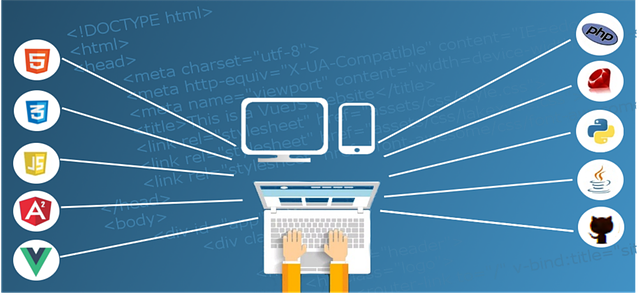Top Web Application Development Frameworks in 2025
The landscape of web application development is constantly evolving. New technologies emerge, existing ones adapt, and the demand for efficient, scalable, and user-friendly web applications continues to grow. As we look towards 2025, it’s crucial for developers, IT managers, business owners, and tech startups to understand the leading web application development frameworks that will shape the future of the web. This comprehensive guide explores the top frameworks, considering current trends and anticipated advancements.
Navigating the Framework Ecosystem
Web application frameworks provide a foundational structure for building web applications, streamlining development processes, and promoting best practices. They offer pre-built components, tools, and functionalities that handle common tasks like routing, database interaction, security, and templating. Choosing the right framework is a critical decision that can significantly impact a project’s success. This article will delve into the leading frontend and backend frameworks expected to dominate in 2025, offering insights into their strengths, weaknesses, and suitability for different project types.
Understanding the Key Trends Shaping 2025
Before diving into specific frameworks, it’s important to acknowledge the key trends influencing web application development in 2025:
Increased Focus on Performance and Speed: Users expect fast-loading and responsive web applications. Frameworks that prioritize performance optimization will be highly sought after.
Emphasis on Security: With increasing cyber threats, security is paramount. Frameworks with robust security features and best practices will be essential.
Rise of Serverless Architectures: Serverless computing allows developers to focus on writing code without managing servers. Frameworks that integrate well with serverless platforms will gain popularity.
Adoption of WebAssembly (Wasm): Wasm enables near-native performance for web applications, opening up new possibilities for complex and demanding applications.
Continued Growth of JavaScript Ecosystem: JavaScript will remain a dominant force in web development, with frameworks like React, Angular, and Vue.js continuing to evolve.
AI and Machine Learning Integration: Frameworks that facilitate the integration of AI and machine learning functionalities will be in high demand.
Top Frontend Frameworks in 2025
Frontend frameworks are responsible for the user interface (UI) and user experience (UX) of web applications. Here are some of the leading contenders for 2025:
React: React, developed by Facebook (Meta), remains a popular choice due to its component-based architecture, virtual DOM for performance optimization, and large community support. In 2025, we expect to see further advancements in React Server Components, making server-side rendering even more seamless.
Angular: Angular, developed by Google, is a comprehensive framework well-suited for large-scale enterprise applications. Its strong structure, TypeScript support, and robust tooling make it a reliable choice for complex projects. Continued improvements in performance and developer experience are expected.
Vue.js: Vue.js is known for its simplicity, ease of learning, and excellent performance. Its progressive nature allows developers to adopt it incrementally, making it suitable for both small and large projects. We anticipate further enhancements in its ecosystem and tooling.
Svelte: Svelte takes a different approach by compiling code to highly optimized vanilla JavaScript at build time. This results in smaller bundle sizes and improved performance. Its growing popularity is expected to continue in 2025.
SolidJS: SolidJS is a relatively new framework that offers performance comparable to vanilla JavaScript while providing a developer experience similar to React. Its fine-grained reactivity and focus on performance make it a strong contender.
Top Backend Frameworks in 2025
Backend frameworks handle server-side logic, database interactions, and API development. Here are some key players for 2025:
Node.js (Express.js/NestJS): Node.js, with frameworks like Express.js for simplicity and NestJS for structured applications, remains a popular choice for building scalable and performant backend APIs. Its non-blocking I/O model makes it well-suited for real-time applications.
Python (Django/Flask): Python frameworks like Django for rapid development and Flask for more flexibility continue to be widely used. Their extensive libraries and strong community support make them suitable for a wide range of applications.
Java (Spring): Spring remains a robust and mature framework for building enterprise-grade applications. Its comprehensive features and strong community support make it a reliable choice for complex projects.
Go (Gin/Echo): Go’s performance and concurrency features make it an excellent choice for building high-performance backend services. Frameworks like Gin and Echo provide a streamlined development experience.
Rust (Actix Web/Rocket): Rust’s focus on performance and safety makes it increasingly popular for building highly performant and secure backend systems. Frameworks like Actix Web and Rocket offer robust tools for web application development.
Choosing the Right Framework: Practical Considerations
Selecting the right framework depends on several factors:
Project Requirements: Consider the size, complexity, and specific requirements of your project.
Team Expertise: Choose a framework that your team is familiar with or willing to learn.
Performance Needs: If performance is critical, consider frameworks known for their speed and efficiency.
Scalability Requirements: If your application needs to handle a large number of users, choose a framework that supports scalability.
Community Support: A strong community provides valuable resources, documentation, and support.
Security Features: Ensure the framework offers robust security features and follows security best practices.
Real-World Examples and Use Cases
E-commerce Platform: React or Vue.js for the frontend, combined with Node.js (NestJS) or Python (Django) for the backend, would be a suitable choice for building a scalable and feature-rich e-commerce platform.
Real-time Chat Application: Node.js with Socket.IO or Go would be a good choice for building a real-time chat application due to their excellent performance in handling concurrent connections.
Enterprise Web Application: Angular or Java (Spring) would be suitable for building a complex enterprise application with robust security and scalability requirements.
Data-Intensive Application: Python (Flask) or Rust could be suitable for building data-intensive applications that require high performance and efficient data processing.
Web Development Trends and Framework Adaptations
Several key trends will influence framework development in 2025:
Progressive Web Apps (PWAs): Frameworks will continue to improve their support for PWAs, enabling developers to create web applications that offer a native app-like experience.
Serverless Computing: Frameworks will increasingly integrate with serverless platforms, allowing developers to build and deploy applications more efficiently.
WebAssembly (Wasm): Wasm will become more prevalent, allowing developers to write high-performance web applications using languages like C++, Rust, and Go.
AI and Machine Learning: Frameworks will provide better integration with AI and machine learning libraries, enabling developers to build intelligent web applications.
Actionable Advice for Developers and Businesses
Stay Up-to-Date: Keep learning and experimenting with new frameworks and technologies.
Choose the Right Tool for the Job: Carefully evaluate project requirements before selecting a framework.
Prioritize Performance and Security: Ensure your applications are fast, secure, and reliable.
Embrace Modern Development Practices: Adopt modern development practices like continuous integration and continuous deployment (CI/CD).
Invest in Training and Development: Provide your team with the necessary training and resources to stay ahead of the curve.
The Impact on Software Development Tools
The evolution of web application frameworks also drives the development of new software development tools. We can expect to see:
Improved IDEs and Code Editors: IDEs and code editors will offer better support for modern frameworks, including enhanced code completion, debugging, and testing features.
Advanced Build Tools: Build tools will become more sophisticated, enabling faster build times and optimized deployments.
Enhanced Testing Frameworks: Testing frameworks will evolve to provide better support for testing complex web applications built with modern frameworks.
What is a Web Application? A Comprehensive Guide
Embracing the Future of Web Development
The world of web application development is dynamic and exciting. By staying informed about the top web application development frameworks and key trends, developers, IT managers, business owners, and tech startups can make informed decisions and build innovative and successful web applications in 2025 and beyond. Choosing the right framework, combined with a focus on performance, security, and modern development practices, will be crucial for success in the ever-evolving digital landscape. This overview of web development trends and software development tools provides a foundation for future exploration and strategic planning.






